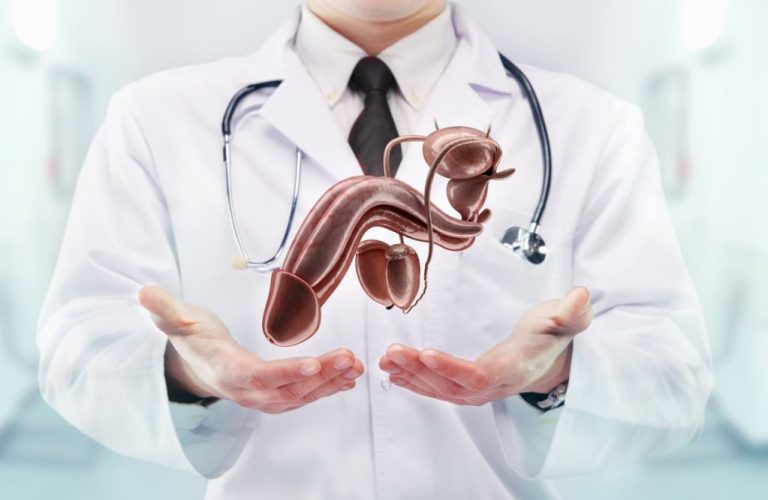Source of pleasure, the erection in men is a symbol of virility. Unfortunately, this action can quickly become unpleasant, even very painful for some people. Very abnormal and worrying, a painful erection must systematically lead to a medical consultation. What are the causes of this pain? When should we be concerned? What treatments are available? Find out from Les Cliniques Marois everything you need to know about erectile pain.
Causes of erectile pain
Pain during erection is not a pathology. Rather, they are symptoms of other more or less serious illnesses that require treatment. The causes of a painful erection can therefore vary depending on the pathology it hides.
-
Lapeyronie's disease
Lapeyronie's disease is a kind of inflammation inside the penis that causes the formation of scar tissue. This causes the penis to bend during erection, making penetration difficult and sometimes impossible. This condition accounts for about two-thirds of erectile dysfunction.
Lapeyronie's disease is often painless when the penis is at rest. On the other hand, during erection, blood pressure will cause pain precisely at the level of the inflammatory plaques (composed of fragmented elastic fibrils and disorganized collagen) formed by the inflammation of the albuginea. Pain during erection is therefore the first symptom of Lapeyronie's disease. In very rare cases, these pains can persist even when the penis is at rest. This can lead to deformation of the penis and sexual problems.
The origins of Lapeyronie's disease are still poorly understood, as it is neither hereditary nor congenital. This pathology appears during the course of life gradually or sometimes suddenly. It is often found in diabetics, patients suffering from hypercholesterolemia, Ledderhosis or Dupuytren. -
Priapism
Priapism is characterized by an intense erection that lasts for several hours without any sexual stimulation. This erectile dysfunction can sometimes be very painful and never leads to ejaculation. During the erection in case of priapism, the glans remains soft and is not swollen at all.
There are three forms of priapism:
- Venous priapism (more frequent, leads to permanent erectile dysfunction if not treated quickly),
- arterial priapism (not very painful, sets in over several days),
- chronic intermittent priapism (related to sickle cell disease and causes a nocturnal erection that can lead to a fibroid of the corpus cavernosum over time).
The causes of priapism vary and may be unknown. In some cases, this condition may be due to the use of erectile dysfunction drugs (Viagra), certain blood pressure treatments, blood disorders, exposure to toxic substances or trauma.
Among the causes related to blood diseases, we can mention sickle cell disease, certain cancers and leukemias, blood drainage disorders through the veins of the corpus cavernosum or myeloproliferative syndrome.
-
Fracture of the penis or corpora cavernosa
Penile fracture refers to the rupture of the membrane that surrounds the corpora cavernosa of the penis (albuginea). Sometimes referred to as a "coital slip", penile fracture is usually caused by heavy pressure on the erect penis during intercourse.
The erect penis contains blood under great pressure to keep it taut and rigid during penetration. Even though the penis does not contain any bones, it can bend if it is not moved properly. A cracking sound is often heard that distorts the penis and swells the testicles. A hematoma quickly forms on the surface of the penis and intense pain sets in, especially if the urethra is ruptured. In this case, blood can flow through the meatus. -
Balanoposthite (balanite)
Balanoposthitis is an inflammation of the glans penis that can affect a man in need of sex, regardless of age. Balanoposthitis is when the inflammation also affects the foreskin. This condition usually manifests itself as irritation, itching, burning, sores and a strong odor. Inflammation and rubbing are often painful.
Balanitis is generally caused by the proliferation of a fungus called Candida albicans. Naturally present in the flora of the skin, the uncontrolled development of this fungus can cause the first symptoms of the pathology. The adoption of an unhealthy and inadequate lifestyle can also aggravate this disorder.
In some cases, balanitis can be caused by streptococcus. It can also be accompanied by chlamydia, a serious sexually transmitted infection. Balanoposthitis can also be caused by an allergy. In this case, it is essential to find the allergenic source in order to avoid it.
To avoid this pathology, it is important to adopt a good intimate hygiene to prevent these infections. Avoid the use of antiseptic soaps and overly aggressive toilets.
-
The penile fracture
The frenulum is a membrane that connects the glans penis and the foreskin. It plays an important role in triggering ejaculation and sexual stimulation. If it is too short, it can cause pain during erection, especially during masturbation or sexual intercourse.
There is no risk of frenulum rupture in circumcised men. Circumcision involves cutting the frenulum and removing the foreskin from the penis. Therefore, circumcised men do not have to worry about this phenomenon.
A rupture of the penile frenulum is a fairly large tear in this membrane. It usually occurs during sexual intercourse and manifests itself as a fairly large amount of blood flow, especially if the artery is ruptured. This phenomenon often occurs in the middle of sexual intercourse in young men who have just begun their sexual life. Often painless, it can be painful in some cases.
-
Idiopathic phimosis
Idiopathic phimosis is as common in children as in adults. This anomaly is characterized by an overly tight foreskin that prevents the glans penis from being uncovered. This causes pain when the patient tries to untwist the glans while erect or at rest.
Most newborns are born with phimosis. With grooming and spontaneous erections, this anomaly disappears naturally. Only 11% of three-year-olds have phimosis, compared to 1% of adults over the age of 18. This is why phimosis is not usually seen in children before the age of 3.
This abnormality can also be seen in adults or adolescents during erections. In most cases, it is a phimosis that has been present since childhood, but has gone unnoticed for one reason or another.
The main symptom of this anomaly is the inability to retract the foreskin over the glans. It can cause local inflammation or infection due to the retention of smegma that cannot be evacuated in adults and children. It can also cause pain or discomfort during an erection.
-
Secondary phimosis related to lichen sclerosus-atrophic
Secondary phimosis is an inflammatory condition of the foreskin that is characterized by the loss of elasticity in this ring of tissue. This will cause small, painful cracks at the tip of the foreskin. This phenomenon can be linked to a forced unhooding in childhood, which leads to cracks or inflammation. This is called sclerotic phimosis. The preputial ring is then very fibrous, narrow and thick.


When should I consult?
Having pain during erection should be worrisome in all cases. Even if some causes are less serious than others, it is important to consult a doctor or a urologist as soon as possible in order to limit the risks of complications.
One of the first reasons you should seek help is if there are visible signs. For example, if you have a penile fracture, you should immediately contact a urologist or your doctor for referral to a specialist. This is also true for priapism, the first sign of which is an intense erection that lasts for several hours (more than 3 hours), without any sexual stimulation.
Another reason to consult a doctor is if you experience a disturbing pain during an erection. Even if this pain occurs when the penis is at rest, it is still wise to consult a doctor to be sure.
Most causes of erectile pain can lead to erectile dysfunction. It is therefore important to consult your doctor to find a solution to the problem. Erectile dysfunction or erectile dysfunction can occur without any pain. It can be an inability to maintain a firm erection until orgasm, to penetrate or to simply get an erection.


Treatments for erectile pain
Treatments for erectile pain generally vary depending on the source of the problem.
-
Treatments and surgeries for Lapeyronie's disease
After clinical diagnosis of Lapeyronie's disease, Les Cliniques Marois offers several methods to treat and cure the condition. The first method is straightening surgery (plication) for Lapeyronie's disease, which is only necessary in less than 10% of cases.
This operation performed by a surgeon aims to reduce the curvature of the erect penis (curvature less than 60°) in order to facilitate penetration and sexual intercourse. It is only necessary in cases of severe penile deformity that makes sexual intercourse difficult or impossible for more than two years.
Platelet-rich plasma treatment with hyaluronic acid for Lapeyronie's disease is also a very good solution to correct the abnormality. This treatment, offered by Les Cliniques Marois, improves the curvature of the penis. This non-surgical procedure requires a simple and painless injection to accelerate the healing of the fibrous plaque responsible for the curvature of the penis.
Shock wave therapy of a painful cavernous plaque for Lapeyronie's disease is also an effective treatment. This therapy consists of applying a probe emitting low-intensity shock waves to the palpable plaque of the cavernous body of the penis. This treatment is done in several sessions and is painless.
-
Surgery for frenulum rupture
The frenectomy or lengthening of the frenulum is a surgical procedure that allows to lengthen this membrane. It is performed under local anesthesia and consists of cutting the frenulum with an electric scalpel. You can perform a frenectomy or frenulum lengthening at Les Cliniques Marois in less than 15 minutes in complete safety. In some cases, stitches may be necessary to control bleeding or if the membrane is large enough.
-
Treatment for balanoposthitis
To treat balanoposthitis, local treatments such as antibiotics, steroids or antifungals may be required. If it is associated with a sexually transmitted infection, it is very likely that the patient will be given oral antibiotics.
In cases where the infection is repeated or the foreskin is narrow and prevents the glans from being uncovered, a circumcision may be considered. Performed under local anesthesia, adult circumcision is a minimally painful operation. Depending on the nature of the problem, the technique used may be different.
-
Treatment for lichen sclerosus-atrophic
To treat lichen sclerosus-atrophic, the appropriate solution is circumcision. At Les Cliniques Marois, a medical center specialized in urology and sexual health, we have state-of-the-art equipment. This allows us to perform complete minor surgical procedures with professionalism and in complete safety.
Pain during erection is not something to be taken lightly. It can have several causes such as Lapeyronie's disease, priapism, phimosis (idiopathic or secondary), balanoposthitis (balanitis) or even a rupture of the penile frenulum. To correct this condition, there are many treatments and surgical procedures adapted to each cause. For an effective correction, consult one of our experienced and competent urologists. At Cliniques Marois, you will receive a warm welcome and effective treatment adapted to your condition.


